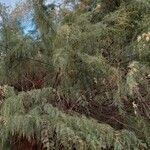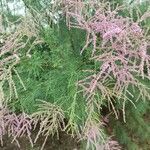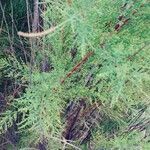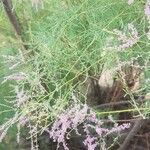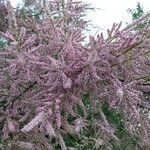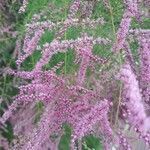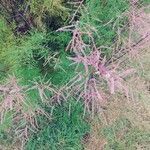Shrub to shrubby tree, 1.5-5.0 m high; bark reddish brown, glabrous. Leaves sessile, base narrow, 1.5-3.5 mm long. Inflorescence 15-70 mm long racemes, initially simple and loose, later dense. Bracts longer than pedicels, triangular-trullate, acuminate, margins ± denticulate. Flowers bisexual, pentamerous. Sepals narrowly-trullate, acute, margins irregularly denticulate to erose. Petals persistent, broadly elliptic-obovate, inequilateral, pink. Disc fleshy, dark-coloured, margins 5-lobed. Stamens 5, antisepalous, inserted beneath disc, alternating with lobes (disc hololophic). Flowering time May-Oct.
Shrubs or trees, to 8 m. Leaves: blade lanceolate, 1.5–3.5 mm. Inflorescences 1.5–7 cm × 3–4 mm; bract exceeding pedicel, not reaching calyx tip. Flowers 5-merous; sepals 0.5–1.5 mm, margins denticulate; petals obovate to elliptic, 1.5–2 mm; antisepalous stamens 5, filaments alternate with nectar disc lobes, all originating from edge of disc. 2n = 24.
Like T. usneoides but bark reddish brown, ± longitudinally wrinkled, leaves green and not stem-clasping and petals various shades of pink.
